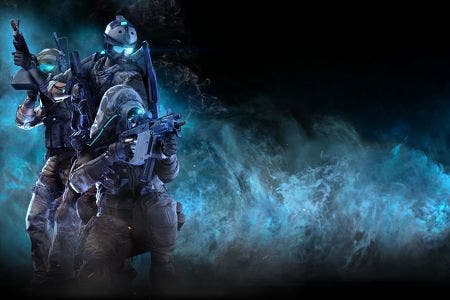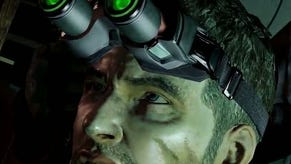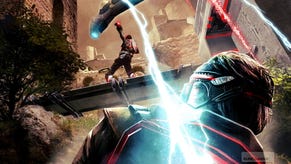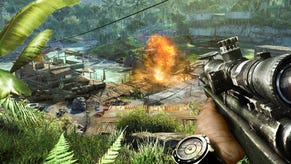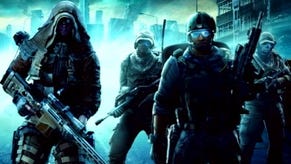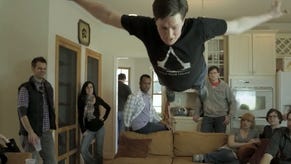Ghost Recon Online Review
Soldier of misfortune.
Somehow, Ubisoft has managed to make a free game feel expensive. At the centre of Ghost Recon Online, which now enters an open beta phase that's tantamount to a full launch, is a competent military team shooter which cleverly subverts its stolid cover tactics with overpowering bursts of exotic, futuristic powers. It's light on content, rough in places, and imperfectly balanced - but the ebb and flow of its action is unusually thoughtful and occasionally thrilling.
Unfortunately, that well-considered core has been rolled around in the muck of micro-transactions which feel at best miserly and at worst predatory, before being delivered to the player in a malfunctioning software package which flouts some of the basic conventions for how respectable programs should behave.
Rating it on the exchange of bullets alone, however, it's a modest but enjoyable thing - a slight offering with only four maps, two game modes and three classes, each being a persistent upgradeable avatar. It's quite possible that this base level of free content will expand, but in a game which charges you for every grenade, you wouldn't want to bet on Ubisoft's generosity.
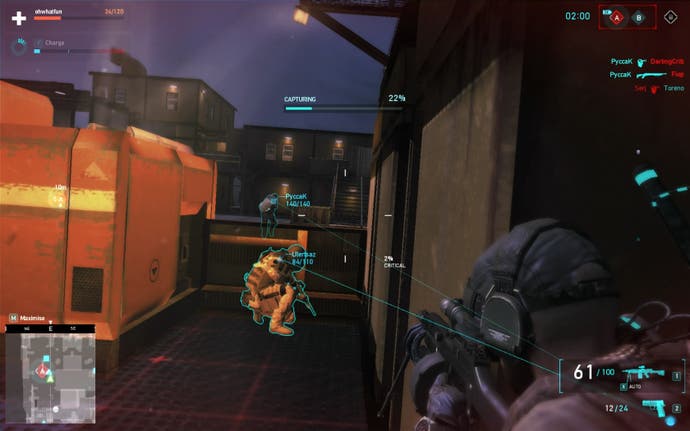
The two modes are similar: one divides the two teams into attackers and defenders, the other is a more-or-less symmetrical tug-of-war, but both involve capturing objectives in sequence. In the attack/defend mode, called Onslaught, the game begins with two objectives, captured simply by occupying the glowing floorspace around a marker for a number of seconds. Once one is captured, the defenders can no longer reclaim it. When both are captured, the defenders fall back to protect a third and final position. The other game mode, Conquest, sees the two teams tussle back and forth over a string of five objectives, with the team which owns the most ground declaring victory when the timer runs out.
None of this will feel alien to players of Battlefield 3, although the levels here are far more confined, designed to accommodate a much more intimate and tactical style of play. Movement is relatively slow, and changes of stance, vaulting or mantling have a languorous pace that encourages you to be very deliberate in your actions. Each environment has been cannily designed with enough approaches to stretch a team's sightlines to the limit, but with the lethality of the weapons giving dug-in defenders a distinct advantage.
What breaks the deadlock are the classes' special powers. Each has two, but only one can be equipped at any time, and they are every bit as dramatic and game-changing as the Medic's Ubercharge in Team Fortress 2 - a peculiar but welcome excess in the otherwise kevlar-flavoured military fantasy of the Clancyverse.
The recon class, which packs sniper rifles or SMGs, can turn fully invisible for a fair number of seconds - plenty of time to skip past enemy lines and line up shots on their backs. One antidote to this is the recon soldier's alternative power, Oracle: a radar ping which highlights enemy silhouettes, whether they are cloaked or not, and which is visible to the whole team.
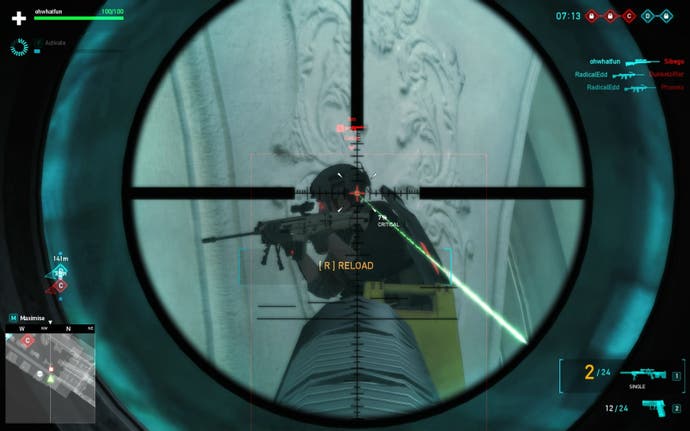
The specialist class, wielding bi-pod friendly LMGs or shotguns, can emit a bullet-deflecting aura or zap enemy electronics with an area-of-effect blast that sends opposing player's screens fitzing. Meanwhile, kitted out with either rifles or shotguns, the assault class can briefly charge the enemy at super-speed, an exoskeleton turning his usual run animation into a comical scamper worthy of Benny Hill while barging enemies aside with a riot shield. Or there's the other choice: a heat weapon that paints the environment in front with debilitating microwaves, rendering enemies blind and unable to fire.
Though some powers can be used to defuse others, the idea isn't so much to create a system of measures and countermeasures as it is to create a surging back and forth between temporarily overpowered teams. When it works, it creates some exhilarating battles, with assault troops smashing through encamped enemy positions while recon troops uncloak in the wings and specialists advance onto the cap with the rest of the team sheltering in their impenetrable aegis. But it is rarely all-out chaos: cooldowns for these powers are long, and persist between spawns, forcing you to deploy them with consideration and coordination.
Of course, consideration and coordination are not necessarily things your team-mates possess - and you can only ever choose to join a game with three friends, leaving half of your eight-man team's tactical nouse to chance. There is no server browser as yet, and no private matches, so your only option is the pot luck of matchmaking.
Although the players will presumably get more expert the longer the game is in the wild, I suspect that the design cultivates behaviour which goes against the objectives of each round. It has, in the idiom of Battlefield 3's community, a Wookie problem. In that game, snipers were outfitted in Ghillie suits resembling Star Wars' fursome friends, and a much lamented portion of players seemed content to lie prone, stoically observing an empty skyline, while the level's actual objectives lay some distance in another direction.

This problem is exacerbated with Ghost Recon, as its sniper class is one of only three available, can't be switched during a game, and isn't terribly malleable. Your close-range alternative to a sniper rifle is a piffling SMG, near useless until upgraded. Naturally, recon soldiers are inclined to sit back at a range which benefits their kill/death ratio - and yet this is entirely the wrong thing to do in Conquest. Eventually, when the recon class unlocks invisibility and enough kit to make their SMG fire slightly more lethal than a heavy fart, it becomes a key tool in circumventing enemy lines. Which brings us to the game's micro-transactions.
I've made purchases in a number of free-to-play games now, and it's always been reasonably clear what I was buying. I put down a fiver for a heavy bolt launcher in the terrific Tribes Ascend and I don't regret it at all: it opened up an entirely different play-style for me. This is not the case in Ghost Recon. You aren't exploring alternative tactical routes, you are simply making yourself less awful at the routes available to you from the start.
I'd say this was a brazenly pay-to-win game, except that it's not always obvious what you're paying for, such is the fragmentation of purchases into individual gun components - new grips, scopes and barrel attachments. This adds a level of gun-nut granularity that some will appreciate, but it also largely obscures the value of those payments. Is it better to buy a new, higher-level gun, or will I be more effective by levelling up my old gun and buying new bits for it? In any case, making my hunk of grey metal handle better by some small percentage does little to excite me compared to a 'sidegrade' which allows me to adopt a completely different tactical role - as offered in many other games.
There are also consumable items to give you a temporary boost - you can buy special ammo to do extra damage, but after that's depleted, you have to buy more. You can buy "armor inserts" that offer health regeneration or added resistance but quickly expire. You always have to buy more grenades, a resource pooled between each of your classes.
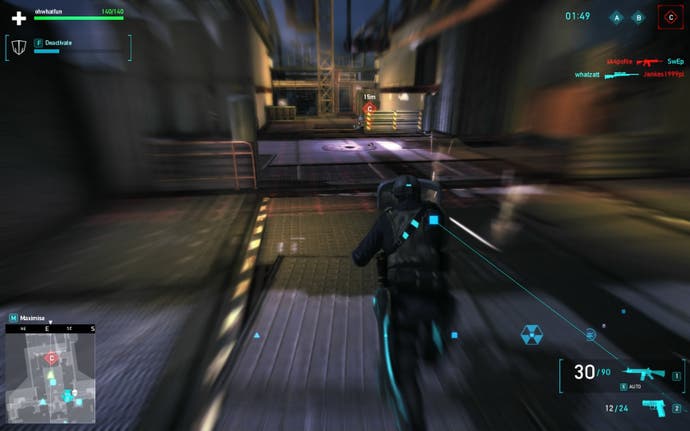
Of course, this nickle-and-diming does not require real nickles and dimes: you can instead spend the Requisition Points which are accumulated during play. Consumables are relatively cheap, too, but it's hard not to resent their continuous drain on your RP funds, which are quickly gone if you covet more effective weapons or the utterly essential squad-boosting abilities which become available for purchase when you hit level seven. It may not require real money, but the spectre of money has nonetheless twisted the system of advancement into something faintly odious.
In the interest of this review, I burnt through a tenner over the course of a few days of intensive play, and yet I really have no idea if what I bought was worthwhile at all. None of my choices have been especially interesting, even if they have directly increased the effectiveness of every bullet I fire; I have not meaningfully expanded the breadth or depth of the game.
Nor do these transactions feel like a reasonable toll exacted for continued access to a game of vast, untapped quality content. This is currently a very small game, and not even one without flaws. Spawn-camping and cap-stealing are dangerously exploitable, and there are a smattering of other oddities that exist in the no-man's-land between ill-judged design decisions and glitches. The Yeti engine, meanwhile, seems to struggle to produce even this rather unpretty game, with bits of scenery flitting in and out in the distance.
Add to this one further gripe: Ubisoft displays some dubious practices during the game's installation [see "Installation situation", left]. Some, perhaps all, of these technical issues will be addressed, I am sure. But at this point it remains hard to recommend this game as enthusiastically as I otherwise would, compromised both by its obfuscatory and exploitative economy and its rickety infrastructure. Its designers have crafted a decent team shooter that, though small and imperfect, offers an alluring, dramatic kernel amid its see-sawing action beats. But the way it's been carved up and served doesn't inspire much appetite.
